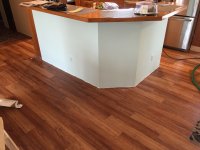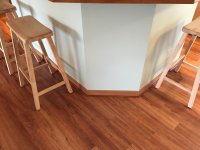tjbnwi said:
(oooooh, oooh, hand raised) Mr. Burt,
I have a question---In the training video you mention interior and exterior primer. As I understand it---------------------------the difference between the 2 is a UV stabilizer is added to the exterior primer??? If this is the case why does it matter where you use which???
On the exterior you should be covering it with exterior paints, the UV rays would not get to the primer, on interior work it should not matter if there is stabilizer or not.
Is there currently a difference between the two besides the stabilizer?
Tom
Tom, that's a great question. The short answer is, I don't know. I'd have to discuss the specifics of that with a product formulator (chemist) specializing in primer to give a factual answer.
That said (here comes the long answer), from a practical standpoint, my comments in the video about latex primers that are rated for both interior and exterior use was a reflection on the progress that has been made in the past 5 years of formulation. Prior to that, we were in dedicated oil primers for interior and exterior use. For us, it was Ben Moore Oil Enamel Underbody for interior wood (trim and cabs) and exterior was mostly Cabot Quick Dry Oil. Both were very good for many years, but have been part of the great bow out to voc regs.
When we switched to latex primers for wood, we used a bunch before settling on a few, specifically Wall and Wood for interior and Multi Purpose for exterior. Little by little, the Multi Purpose started making its way to more and more interior apps.
Performance wise, user experience wise, there is little detectable difference between the two. So subtle, that most users may not notice (it's mostly in the nature of how they sand). However, I wouldn't dare to put W&W on the outside of the house.
A quick check at the SW website will provide msds, pds and eds for all of the products. While those documents are like a foreign language, I can decipher just enough to gather in the comparison of W&W to MP that they have different ingredients, different formulations, which I suspect are in the binders. I also notice that one is recommended to be applied above 50* and the other above 35*.
Conventional wisdom, based on using all manner of these things since the 80s, would lead to the conclusion that exterior rated products need to have more elasticity to deal with greater movement of wood. So, softer more flexible coatings have been desired. They also need to have higher hiding capabilities and more mildewcide. Interior generally aren't subject to as much movement, but do meet with a lot more direct wear and tear, and therefore cleaning, scrubbing, etc. So, it has historically been more important for these coatings to be harder (in body and sheen). Of course, there are always exceptions, as I have found myself with pressure washer wand in hand sniping bird crap off exterior trim many times.
So, back to your question, I don't know but I suspect that there is more to it than the uv consideration, although that is a big difference between interior and exterior exposures. And I think that your theory that as long as the topcoat of paint had the uv thing going on, the primer shouldn't matter. That I would disagree with, as it is the entire surface and substrate that heats up in direct sunlight, not just the coating.
There again, as I am not a chemist, I don't know the ins and outs of the correlation between uv rating and surface temperature. But if one doesn't include the other, in my opinion, they should be rated of similar importance. Bottom line, I want my most bullet proof adhesion at the primer to substrate level. And coatings do fail a lot more on exterior, so it's really not an easy place to experiment. The interior and/or exterior rating is one of the few places I've never dared stray far from mfr intended usage.
It would be a fun question to pose to a good chemist, although I suspect I'd get an answer that I get frequently...that the specifics of it would be proprietary and can't be shared. Even so, I'd take an explanation in generalized terms.
I'll add it to my list of questions that need answering...




